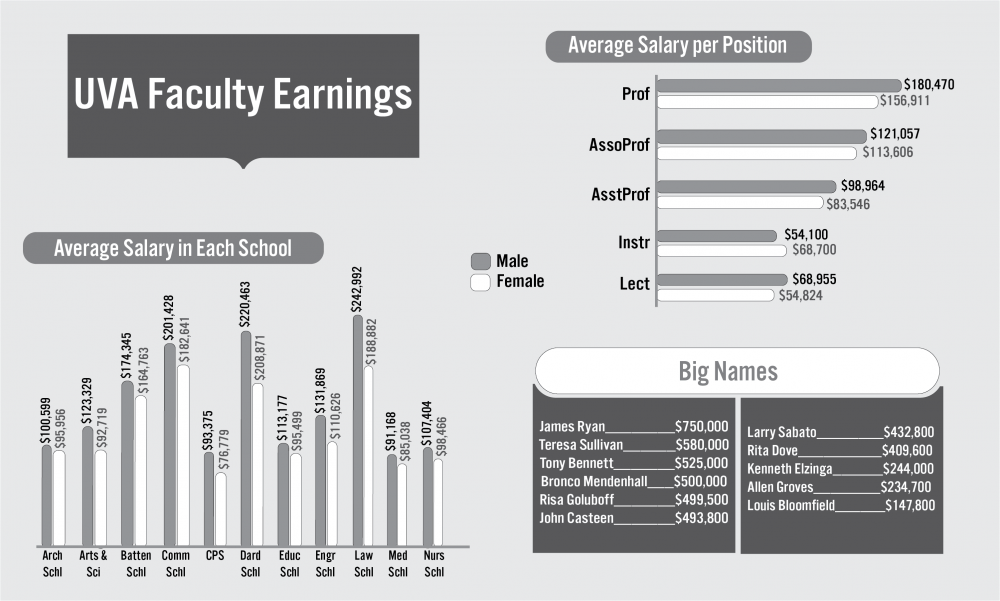Faculty and administration salaries for the 2018-2019 academic year show that the number of women across all divisions in the top 20 earners at the University has increased from two in the 2015-2016 academic year to six women this year. Data obtained by The Cavalier Daily through a Freedom of Information Act request regarding the gender breakdown of average faculty salary for the Oct. 25, 2018 census file showed that women faculty members across all schools at the University earned $33,939 less than men.
Among the six women in the top 20 earners are Martha Zeiger, chair of the department of surgery at the School of Medicine; Teresa Sullivan, former University president and sociology professor; Carla Williams, director of intercollegiate athletic programs; Jennifer “J.J.” Wagner, executive vice president and chief operating officer; Risa Goluboff, first female dean of the Law School; and Katherine Peck, chief operating officer of the School of Medicine.
Zeiger — whose salary is $629,000 — is the third highest paid faculty or administration member at the University, after Richard P. Shannon, the executive vice president for Health Affairs of the the Medical School, and President Jim Ryan — who make $795,500 and $750,000, respectively.
The Law School saw the largest discrepancy in faculty salary, with men on average earning $54,100 more than women. By school, male faculty in the College earns an average of $30,610 more than female faculty, $21,243 for Engineering, $18,787 for Commerce, $17,678 for Curry, $16,596 for Continuing & Professional Studies, $11,592 for Darden, $9,582 for Batten, $8,938 for Nursing, $6,130 for Medicine and $4,643 for Architecture.
The data also revealed that male professors at the University are paid an average of $23,559 more than female professors, earning $180,470 and $156,911, respectively. By academic rank, male associate professors earn $7,451 more than female associate professors, male assistant professors earn $15,418 more than female assistant professors and male lecturers earn $14,131 more than female lecturers, who deliver instruction primarily to a class or group.
Female faculty earned more than male faculty in only one academic rank — instructor, which includes positions that deliver instruction primarily to individual students, including clinical supervision and musical instruction. Female instructors earn an average salary of $68,955 — $14,855 more than male instructors.
In an email to The Cavalier Daily, University spokesperson Anthony de Bruyn addressed the complex nature of determining gender inequity in his email, stating that in order to properly address the apparent gender gap, one would need to account for many different factors like education and tenure that the FOIA doesn’t necessarily take into consideration. He also stressed that it is challenging to accurately compare male and female salaries at the University because of the number of factors that go into determining it.
“Assessing the multifaceted performance of a diverse faculty of independent scholars is not a process readily quantifiable by a simple numerical scale or institutional average salary data,” de Bruyn wrote.
He also emphasized that “pay equity or salary fairness among faculty is a constant process considered within the UVa compensation system and informed by federal law.”
Faculty compensation is determined at the school level and takes into account many different factors, such as faculty classification, performance, honors and recognition in teaching, professorial rank, years in rank, market forces and administrative responsibilities like serving as a chair.
De Bruyn added that the University tries to maintain an average salary per discipline that is competitive with salary averages published by its peer institutions.
“The University’s compensation philosophy supports UVA’s goal to attract, develop, and retain employees using market-based salary ranges and pay practices that reward performance and development,” de Bruyn wrote.
In 2014, the Office of the Executive Vice President and Provost’s Faculty Salary Study Task Force issued its first detailed salary study of tenured and tenure track faculty. The task force was given confidential access to extensive quantitative information regarding tenured and tenure-track faculty in all of the schools except Medicine for 2003, 2007, 2012 and 2013.
Although there were many important variables, such as rank, school or department and tenure, the task force determined that on average, for the 2013 salary data, male faculty members earned 2.7 percent more than female faculty members — averaging an annual difference of $3,638. It was noted in the report summary that the task force did not incorporate qualitative factors that may affect salaries in individual cases, such as education and tenure.
The gender gap in the 2013 data was larger at the associate and full professor ranks and reversed at the assistant professor rank. The mean salary for male full professors was $154,405, while $139,261 for female professors.
The report also noted that “[m]en not only constituted a large majority of the faculty (about 71%), but they also have been at the University for a longer period of time.” Men on average had been at the University for 18.5 years, versus 12.4 years for women.
Field of specialization also played a substantial role in determining compensation among faculty. The report noted that although women’s share of engineering doctorates had increased from 0.46% in 1970, the year the University became coeducational, the University still “faces a market supply of potential faculty candidates that tends to reinforce existing gender disparities in representation between higher-paying and lower-paying schools and departments.
In fall 2017, the University had 906 male faculty members and 578 female faculty members in 2017. By academic rank, this includes 431 male professors and 135 female professors, 219 male associate professors and 161 female associate professors, 208 male assistant professors and 213 female associate professors, and 46 male lecturers and 66 female lecturers. The University had two male instructors and three female instructors.
De Bruyn emphasized that the University “remains committed to equitable compensation for all of its employees and will continue to assess its practices to ensure that commitment moving forward.”
Abby Palko, director of the Maxine Platzer Lynn Women’s Center, also touched upon the various factors and the difficulties of parsing out why the pay gap exists in the United States.
“[The wage gap] is not a U.Va. specific thing — it’s a U.S. society thing,” Palko said. “The assumptions that go with gender run really, really deep.”
According to a March 2019 national study by the Pew Research Center, women earned 85 percent of what men earned in 2018.
“The best curated research shows that you can account for some of it by choice of profession and some of it by parental status, but not all of it,” Palko said. “Some of it can only be explained by gender.”







